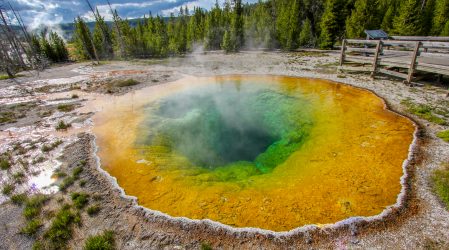Today we will focus solely on geysers and hot springs while visiting Yellowstone National Park. We are going to visit Lower Geyser Basin, Midway Geyser Basin, Biscuit Basin, Black Basin and Upper Geyser Basin.
You can find the first two days of visiting Yellowstone here:
We are now heading south through the western part of the Grand Loop Road. The Fountain Paint Pots Trail will be our first stop of the day.
Lower Geyser Basin
Fountain Paint Pots Trail
To go through the entire loop around Paint Pots we will have to walk 0.6 miles (1 km). First on our list is the Celestine Pool Geyser. It has an exceptionally intensive color, which is a result of high temperatures inside the geyser. The water temperatures in the Celestine Pool exceeds boiling. Unfortunately in 1981 a tourist boiled to death here, as he was trying to save a dog that had fallen into the water.
Further down the walkway the Silex Spring awaits. This is a beautiful pastel-blue spring, with water constantly flowing out of it, and the bacteria inhabiting it create amazing long yellow-orange stripes.
The Leather Pool also deserves your attention. Once sapphire-blue, today it is colorful, as the water had cooled down, and thus made it possible for the bacteria to live there. Before the earthquake of 1956 the pool was also colorful, but the water warmed up later, killing the bacteria and changing the color of the lake. Today the pool is colorful once again, what is a testimony to the fact, that Yellowstone is an ever-changing and evolving landscape.
Fountain Geyser, not to be confused with the Great Fountain Geyser, is another one along our way. It is hard to predict its eruptions, as it goes off every 4 to 15 hours, but when it finally does erupt, the water spills literally in all directions, which is incredibly spectacular. The water can reach up to 79 feet (24 m) high.
Right next to it the Clepsydra Geyser is located. It is a picturesque colorful geyser, and what is more it is really tourist-friendly, as it is basically active all the time and constantly erupts. It calms down only when his neighbor – the Fountain Geyser – is about to erupt.
Fountain Paint Pots is a highly active area, you can be basically sure that you will witness an eruption during you visit. There is a plethora of larger and smaller geysers, hot springs and fumaroles, something constantly erupts, boils and hisses here. If you do not stop and wait for an eruption of a specific geyser, then the entire walk should take you approximately 30 minutes.
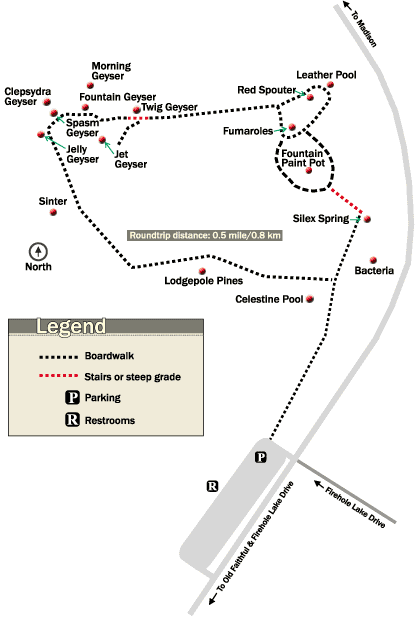
Firehole Lake Drive
Now we drive further down the Grand Loop Road and after 1,1 miles we turn left onto the Firehole Lake Drive. This is a one way road which is 3 miles long and will take you to amazing springs and geysers.
The first spring that we will visit is the Firehole Spring. There are both a parking and a viewing point there. Firehole Spring is very colorful, and the bacteria in the water flowing out create amazing colorful patterns around it. This place is definitely worth a stop.
Literally a dozen feet further we have the Surprise Pool, a pool with exceptionally dark shade of blue.
Just around the corner the Great Fountain Geyser awaits. It is one of the most beautiful and spectacularly erupting geysers in entire Yellowstone. There are terraces similar to those in Mommoth Hot Springs around. They entwine our geyser, which erupts to the height of 220 feet (68 m). Unfortunately it goes off very rarely, and you have to wait 9 to 15 hours. But when it does erupt it throws water cascades into the air for over an hour, and sometimes even up to 2 hours. The eruption usually consists of several eruptions, with a couple minutes long intervals between them.
Now we reach the White Dome Geyser. It is a massive geyser that can be seen from afar, its cone is over 13 feet (4 m) tall and it is one of the largest geysers in the park. It is also very tourist-friendly, erupting every 20-30 minutes. The water thrown into the air reaches 30 feet (9 m) high.
The Pink Cone Geyser is our next stop. Just as the name suggests its cone is pink, which is caused by magnesium and iron oxides. Its shape is also very interesting and eruptions are exceptionally pretty, but sadly also very rare. Pink Cone Geyser goes off every 18 to 25 hours, but the eruption lasts from 1,5 to 2 hours.
The Firehole Lake itself with the neighboring Hot Lake are our final stops along the Firehole Lake Drive. Both have a rusty color, as a result of thermophilic bacteria activity.
Midway Geyser Basin
After leaving the Firehole Lake Drive we have only 2 more miles to drive to the Midway Basin, and to the one of the most amazing natural wonders in the world – the Grand Prismatic Spring.
The parking at the Midway Geyser Basin is fairly large, but it is not easy to find a parking spot. If you do not find one, just make another pass around the parking lot, the rotation of cars is big here, and at some point you will find a place.
After a successful parking spot hunt, we go to the other side of the Firehole River and begin our walk on wooden walkways. To the right just behind the entrance you will see the Excelsior Geyser, or rather what’s left of it after the eruption of 1880. It used to be the largest geyser in the world with eruptions reaching 310 feet (94 m) high. The powerful eruptions finally blew the geyser and its underground system into pieces and left a colorful spring in its place, from which water constantly pours.
Slightly further to the right we have the Turquoise Pool. Its name comes from the beautiful oval shape resembling a gem, and its blue water with a milky tint. The mineral particles in the water are responsible for that. They also cause opalization of the pool. Those visiting at the beginning of summer can see blooming purple flowers growing around.
Right next there is the Opal Pool, similar to the Turquoise Pool, but a lot smaller.
Grand Prismatic Spring
And finally it is time for the famous Grand Prismatic Spring. This is the third largest thermal spring in the world, and certainly one of the most amazing places on our globe. Unfortunately you are most likely to be disappointed. Please believe me, you won’t see much from the walkways around the spring. When we arrived here for the first time we struggled to see anything, as the vapor obstructed the view. The case with the Grand Prismatic is kind of similar to the one with the Nasca petroglyphs – they are visible from above. Disappointed by the view I started looking around for a hill or something. An there it is! It is not too close to the lake and at the other side, but still, it exists!
A quick order to get to the cars and both of our vehicles headed for the hill, searching for a spot to park. We recalled that at the other side of the lake there is a trail leading to Fairy Falls with a small parking. To get there you have to drive 1.6 miles from the Grand Prismatic parking, but we managed to get there and find a place to park. We set off in search for a way up the hill. Taking the Fairy Falls trail we moved towards it. After about 1.2 miles (2 km) we realized that we are about in line with the spring and started going uphill.
We swiftly discovered a net of paths and footprints on the hillslope, indicating that we were not the only ones to try this hill out. The climb was hard, we kept sliding back on a steep sandy slope, and downed trees kept blocking our way. Some of them were so big that we barely managed to go over them. By this time we were all covered in black volcanic dirt, and my husband ripped his pants on some tree branch, which were ironically advertised by the producer as indestructible.
But it was worth it! Halfway up the hill we already had an amazing view, slightly obstructed by trees, but we didn’t really care. We could finally see the spring, its crazy colors and orange stripes crawling out of it. If you want to see a million dollar view – this is it!
My son climbed to the top of the hill (we were satisfied by ¾ way up) and brought us fantastic pictures of the spring, which from this perspective looks like a monster from outer space, crawling through a grey wasteland.
When we made our way down we were in the center of attention among other tourists, as we were all dirty and my husband with his ripped pants, looked as if he had been fighting with a bear. The 7 of us looked clearly different from the other clean hikers of various nationalities.
From that day onwards we always climbed this hill, avoiding the wooden walkways around the spring.


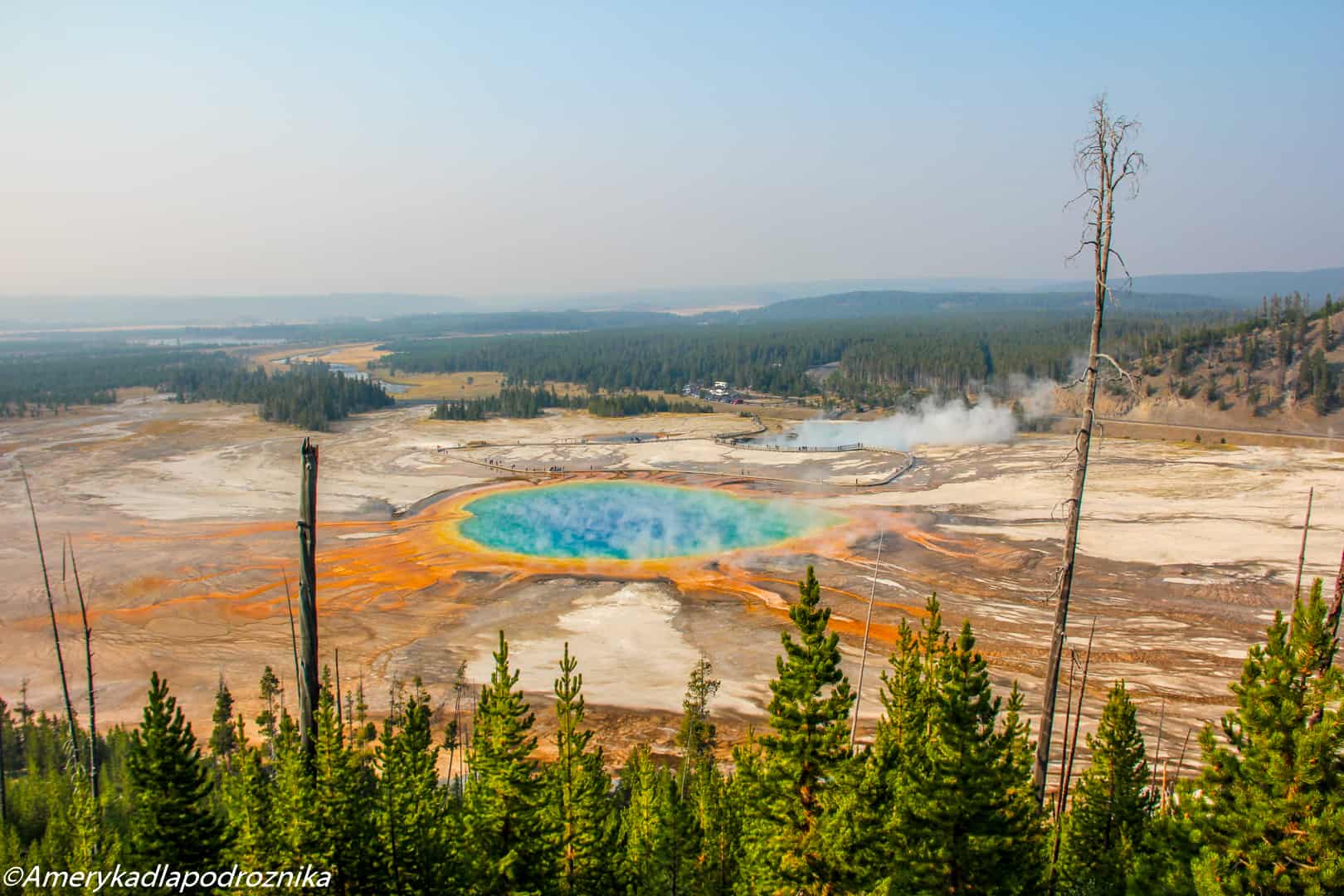
The situation changed drastically in 2017. The park decided to build a dedicated viewing platform, so that tourists could finally see the spring. We were very excited to see how it turned out and what the view would be. The trail to the platform leads through the same way that we took to climb the hill. The a large parking was added, where we immediately found a parking spot. So far so good. After around 0.8 miles (1 km) we noticed a paved path leading uphill. This can’t be! They paved the whole way up? But after a couple hundred feet it turned up not to be true. The viewing platform had been built on a fairly low elevation, which does give you some view of the spring, but not as good as it could have been, if the platform had been built higher. All the trees blocking the view have been removed, but it is still not it! We started looking for a way to go higher, but our search was futile. The slope is now surrounded by wooden barriers and ditches dug in the ground. Too bad, we took some more pictures of the spring from the platform, all agreeing that the colors aren’t that spectacular from this height.
This platform may not be the best solution ever, but you definitely have to climb up there. What you will see is still overwhelmingly beautiful and it is a mandatory stop during a trip to Yellowstone.

How come is the Grand Prismatic Spring so colorful?
Similarly to the smaller springs it is all due to bacterial activity. In the center the lake is blue, because it is incredibly hot 189oF (87oC), close to boiling, which makes it impossible for microorganisms to reside there. Further away from the center the water gets cooler, and thus friendlier for the bacteria.
Cyanobacteria are responsible for the yellow ring around the spring. They usually create greenish-blue tint, because they contain chlorophyll, but those clever little guys produce a different dye – carotene, well known for residing inside carrots, which protects them from the very intensive solar radiation reflecting from the spring surface. The temperature in the yellow ring is around 165oF (74oC)
The next ring around the Grand Prismatic Spring is orange. This is the ring which produces the orange stripes around the blue spring. Water here is around 149oF (65oC).
Further away from the spring we can find other types of bacteria that prefer lower temperatures. There are microorganisms producing carotenoids generating the red-brown and burgundy colors in the 131oF (55oC) water. The environment is a lot less harmful here, so there is more bacteria, and the colors become darker.
The colors of Yellowstone are defined by various life forms that have settled here. The colors are constantly changing. If for example the water becomes to hot, the bacteria die out and the colors vanish. When it cools back down, life returns to the water and so do the colors. The Grand Prismatic Spring itself is a little bit less colorful in winter, as there is less solar radiation, so the bacteria produce less carotenoids.
Fairy Falls
After finishing gazing at the amazing Grand Prismatic Spring we can walk further along this trail to the Fairy Falls. This is a very tall waterfall, the water falls from 200 feet (61 m) above. From the viewing platform you will have to walk around 4.7 miles (7,5 km) both ways. The trail is very easy. Despite its height the waterfall is not that spectacular, as larger amounts of water flow through it only in spring. If you want you can go additional 1.2 miles (2 km) and reach the Sprey Geyser and the Imperial Geyser. The first one goes off almost all the time with a couple minute pauses between eruptions. However, they are not too gorgeous with water reaching not higher than 6 feet (2 m). Imperial Geyser is currently only a hot spring which occasionally bubbles. Recently a new outlet appeared next to it and it was christened the New Imperial Geyser. This one also erupts almost all the time with water reaching 50 feet (15 m) up. Important: you should not go to the Fairy Falls if you have only 3 days or less for sightseeing Yellowstone. These falls will not fit in a 3 day visit plan.
Upper Geyser Basin
Upper Geyser Basin – the kingdom of geysers, is going to be our next stop. Here you will find more than 300 geysers, as this area is the largest geyser concentration in the world. We first head to the Old Faithful Village, from where we will begin our sightseeing.
You will always find a parking spot at the huge parking lot, but usually the spot will be quite a walk away. Driving around in hope of finding a closer parking place is useless. Many people come up with this idea and they often block the road. It will always be quicker to go by foot.
How to watch the geysers in Yellowstone?
The geysers themselves, unless they erupt, are nothing interesting – just a hole in the ground decorated by a cone. But this is not what we are after, we want to see them erupt. This is why geyser gazing is time-consuming, and requires cleverness, predicting skills, the ability to count and lastly – running skills.
There are two kinds of geysers – the predictable and the unpredictable ones. The first ones have a fairly precisely set times of eruptions. The other ones go off whenever they please. What is surprising, there is more of the predictable ones. But watching a geyser erupting every 1, 2 or 3 hours is a piece of cake. The ones that erupt every 15 hours require some luck.
How to be there in the right time for the eruption? The estimated hours of eruptions of some of the 300 geysers are given by the Old Faithful Visitor Center. It is worth to come in here after successfully parking. On a special board you will find predicted eruption times for the following geysers: Old Faithful, Daisy, Grand, Castle, Riverside and Great Fountain. Now all that we have left to do is prepare a sightseeing plan. Sometimes two geysers erupt at the same time. In that case you will have to choose the one which goes off less frequently and estimate the next eruption of the second one.
What will foreshadow a coming eruption? If you can see from afar, that steam starts rising from a geyser, it is worth checking out. Such vaporing can last for about 15-30 minutes, but after that there is usually an eruption. There is also a chance that nothing will happen, even though we stood there foolishly for 30 minutes. This is a risk that you will have to accept, so it is good to have at least half a day reserved for the Upper Geyser Basin.
Geyser eruptions usually last a couple minutes, sometimes more. Having some sprinting skills and mastering the phrase “get out of my way” in multiple languages will increase your chances of witnessing and eruption. Naturally, the geysers next to which we stood a second ago tend to erupt just as we walk away. Apparently the area is run by a malicious algorithm, which takes our current GPS location into consideration. 😉
The walk through the Upper Geyser Basin with all the important stops included is around 3.7 miles (6 km) long (without the Observation point 2.4 miles). The walk leads mostly on wooden walkways looping around the key attractions.
Old Faithful
As I mentioned earlier, you should first head to the Visitor Center, to get to know the predicted eruption times. Almost certainly the Old Faithful is going to be the first one to go off, as it erupts the most frequently. The park states on its website, that it erupts every 60-100 minutes, but I witnessed eruptions every 60 minutes, give or take additional 10 minutes. But if the eruption lasts longer than the usual 2.5 minutes, the geyser can then be late even half an hour.
You can sit on a bench in front of the geyser as if it was a showroom. If you have children or if you are not too tall, I recommend to secure places in the first row. In order to find such a spot you will have to arrive there 30 minutes prior to the eruption. This time will not be lost, as you can use it to consume your lunch. You can be absolutely certain that there will be some people that will seat just in front of you on the grass. There would be nothing wrong with that if they didn’t stand up to take pictures of the eruption and block the view for others. After a couple of such experiences we developed some countermeasures. We placed all of our belongings in front of us: backpacks, coats and bags. You can even bring something from your car which is standing nearby on the parking lot. This will make those people sit next to, and not in front of you, at least not block the view for you.
As I mentioned, the eruption usually lasts around 2.5 minutes, but it sometimes stretches to 5 minutes. The geyser shoots water up to 131 feet (40 m) but there were 183 feet (56 m) eruptions. The water has 204oF (96oC).
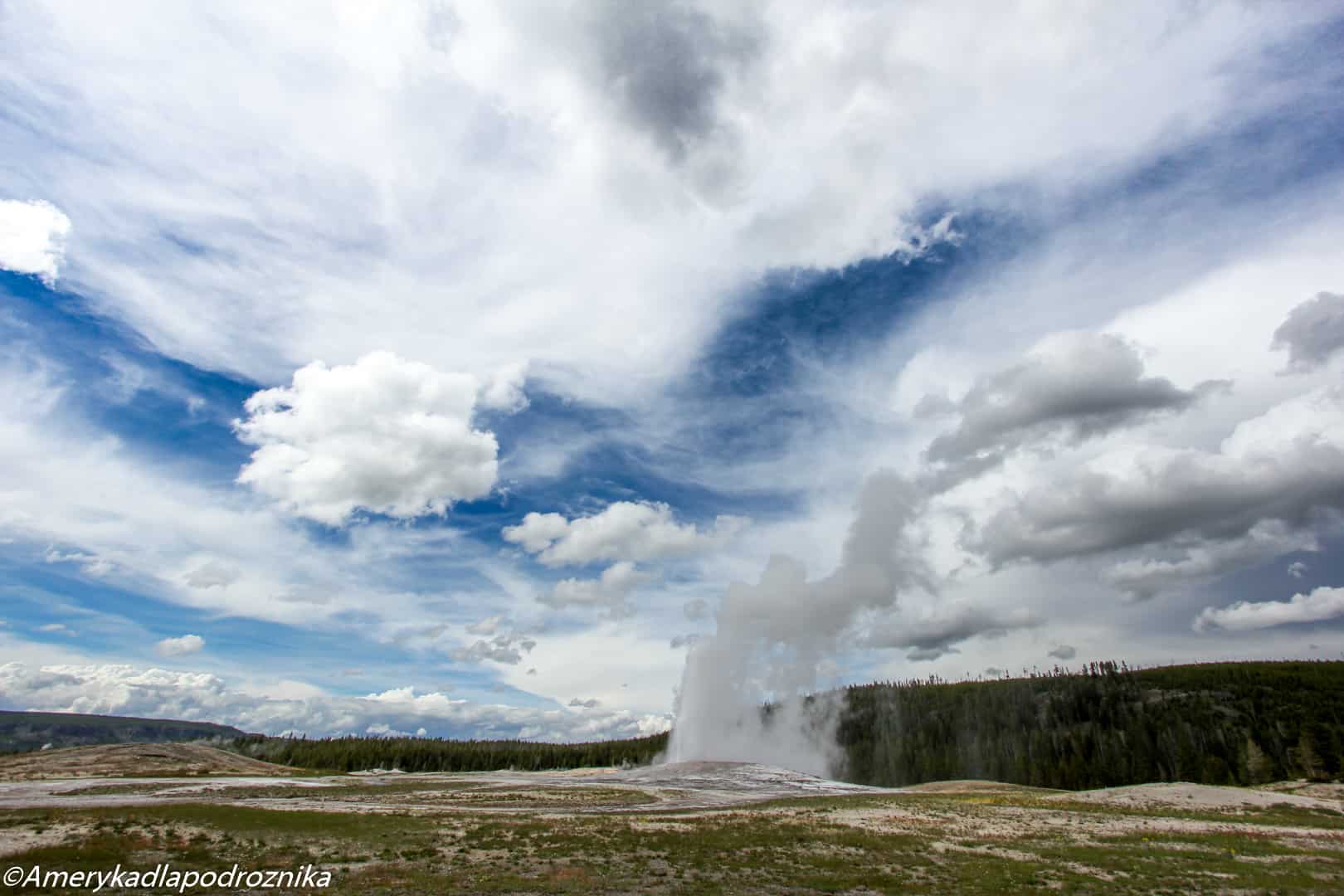

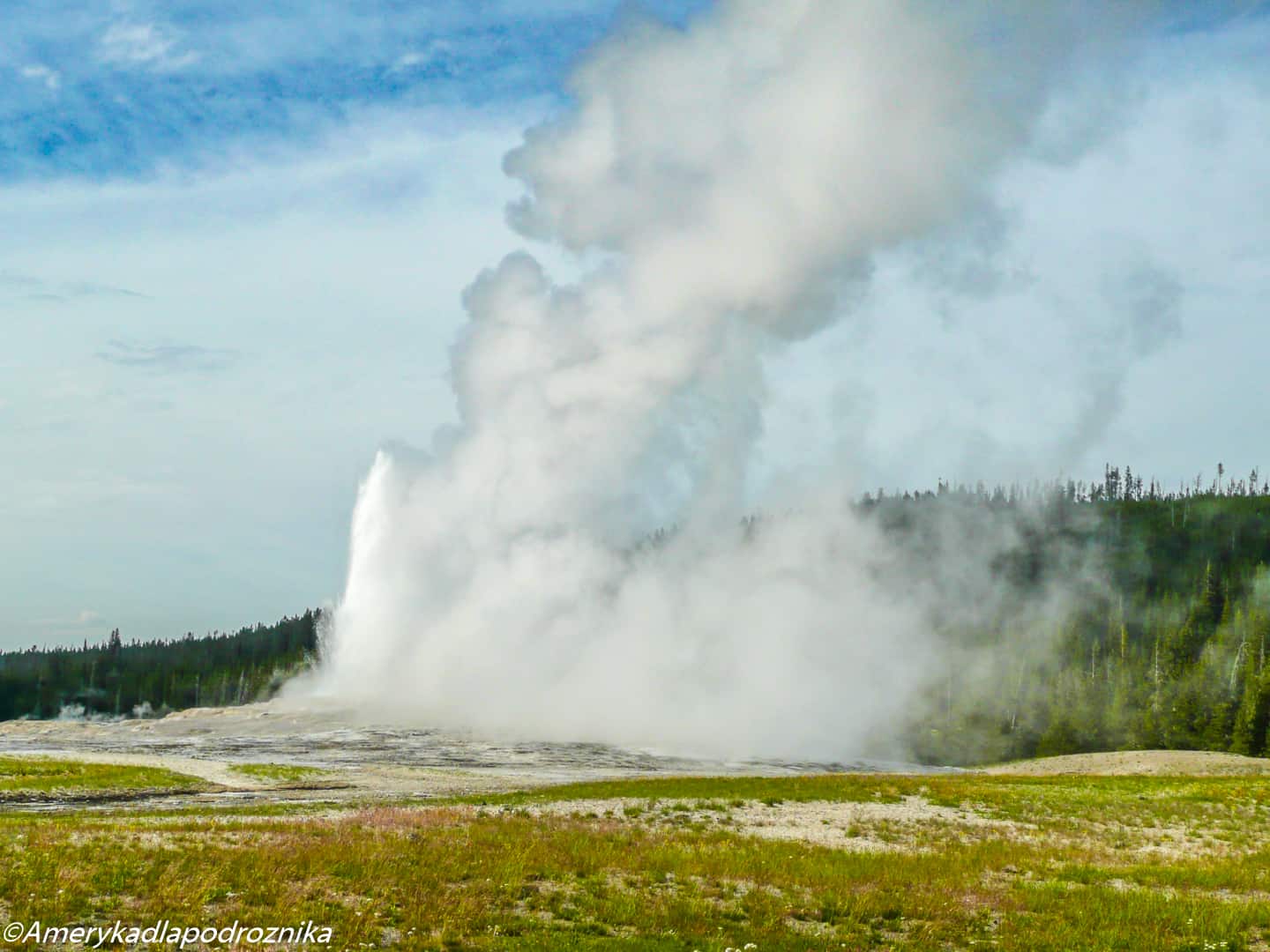
CONTINUE READING:

